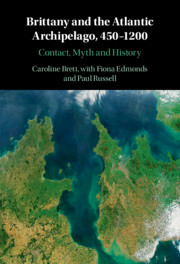Book contents
- Brittany and the Atlantic Archipelago, 450–1200
- Brittany and the Atlantic Archipelago, 450–1200
- Copyright page
- Contents
- Maps
- Tables
- Preface and Acknowledgements
- Abbreviations
- Additional material
- Introduction
- 1 Archaeology and the Origins of Brittany
- 2 Settlement and Isolation, 450–800
- 3 Brittany and Its Insular Past in the Ninth Century
- 4 Insular Contact and the Manuscript-Culture of Brittany in the Ninth and Tenth Centuries
- 5 From Invasion to Conquest: Brittany and Its History, 919–1066
- 6 Saints and Seaways: The Cult of Saints in Brittany and Its Archipelagic Links
- 7 Bretons and Britons in the Norman and Angevin Empires, 1066–1203
- Conclusion
- Bibliography
- Index
Introduction
Published online by Cambridge University Press: 21 October 2021
- Brittany and the Atlantic Archipelago, 450–1200
- Brittany and the Atlantic Archipelago, 450–1200
- Copyright page
- Contents
- Maps
- Tables
- Preface and Acknowledgements
- Abbreviations
- Additional material
- Introduction
- 1 Archaeology and the Origins of Brittany
- 2 Settlement and Isolation, 450–800
- 3 Brittany and Its Insular Past in the Ninth Century
- 4 Insular Contact and the Manuscript-Culture of Brittany in the Ninth and Tenth Centuries
- 5 From Invasion to Conquest: Brittany and Its History, 919–1066
- 6 Saints and Seaways: The Cult of Saints in Brittany and Its Archipelagic Links
- 7 Bretons and Britons in the Norman and Angevin Empires, 1066–1203
- Conclusion
- Bibliography
- Index
Summary
In Brest, at the far end of Brittany, on winter mornings, people go to work in the pitch dark. They keep the same time as Paris and Berlin, but their city is further west than most of Britain, where the clocks are set an hour earlier. It is a concrete illustration of the uneasy way in which Brittany, a long, low, folded peninsula of granite and slate, about the same size as Wales, fits into the centralised, Continental power that is modern France.
- Type
- Chapter
- Information
- Brittany and the Atlantic Archipelago, 450–1200 , pp. 1 - 31Publisher: Cambridge University PressPrint publication year: 2021

